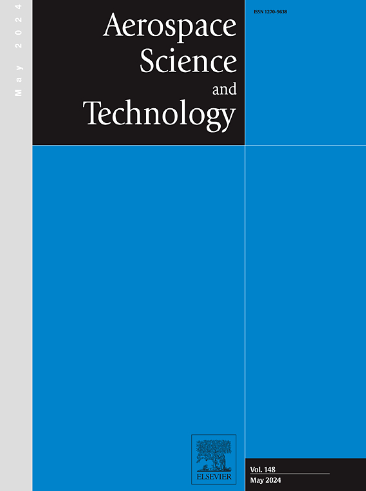On the optimal size of square-lobed trailing edges in transonic flow over a backward-facing step
IF 5
1区 工程技术
Q1 ENGINEERING, AEROSPACE
引用次数: 0
Abstract
Controlling flow separation and reattachment in transonic conditions over a backward‐facing step (BFS) is a critical challenge with significant implications for drag, noise, and structural stability. Square‐lobed trailing edges have emerged as a promising passive flow control strategy. In this study, we extend previous research by investigating an unprecedented range of lobe protrusion heights (LPH), from the traditional 0.4ℎ up to 1.0ℎ. To determine whether larger geometries offer additional performance benefits. Using a combination of Reynolds-Averaged Navier–Stokes (RANS) and Detached Eddy Simulation (DES) at a transonic Mach number of 0.8 and a Reynolds number of 1.8 × 105, we analyse the influence of LPH on reattachment lengths and three-dimensional flow dynamics. For clarity, we differentiate between the “peak” region (upper edge) and the “valley” region (lower edge) of the step. The results indicate a significant reduction in the valley reattachment length as LPH increases, while the shortest reattachment length in the peak region occurs at LPH = 0.6ℎ, with less pronounced differences at higher LPH values. DES reveals that larger LPH configurations enhance the stability and organisation of lateral vortices, reducing chaotic flow behaviours compared to the baseline BFS.
后向台阶跨声速流动中方形叶状后缘最优尺寸的研究
在跨声速条件下,通过后向台阶(BFS)控制流动分离和再附着是一项关键挑战,对阻力、噪声和结构稳定性都有重大影响。方形后缘已经成为一种很有前途的被动流量控制策略。在这项研究中,我们扩展了之前的研究,研究了前所未有的肺叶突出高度(LPH)范围,从传统的0.4 到1.0 。以确定更大的几何形状是否提供额外的性能优势。在跨声速马赫数为0.8、雷诺数为1.8×105的条件下,采用Reynolds- average Navier-Stokes (RANS)和分离涡模拟(DES)相结合的方法,分析了LPH对再附着长度和三维流动动力学的影响。为了清晰起见,我们区分了步骤的“峰”区域(上边缘)和“谷”区域(下边缘)。结果表明,随着LPH值的增加,谷区再附着长度显著减小,而峰值区再附着长度最短的出现在LPH值 = 0.6 处,高LPH值时差异不明显。DES表明,与基线BFS相比,更大的LPH配置增强了横向涡的稳定性和组织,减少了混乱的流动行为。
本文章由计算机程序翻译,如有差异,请以英文原文为准。
求助全文
约1分钟内获得全文
求助全文
来源期刊

Aerospace Science and Technology
工程技术-工程:宇航
CiteScore
10.30
自引率
28.60%
发文量
654
审稿时长
54 days
期刊介绍:
Aerospace Science and Technology publishes articles of outstanding scientific quality. Each article is reviewed by two referees. The journal welcomes papers from a wide range of countries. This journal publishes original papers, review articles and short communications related to all fields of aerospace research, fundamental and applied, potential applications of which are clearly related to:
• The design and the manufacture of aircraft, helicopters, missiles, launchers and satellites
• The control of their environment
• The study of various systems they are involved in, as supports or as targets.
Authors are invited to submit papers on new advances in the following topics to aerospace applications:
• Fluid dynamics
• Energetics and propulsion
• Materials and structures
• Flight mechanics
• Navigation, guidance and control
• Acoustics
• Optics
• Electromagnetism and radar
• Signal and image processing
• Information processing
• Data fusion
• Decision aid
• Human behaviour
• Robotics and intelligent systems
• Complex system engineering.
Etc.
 求助内容:
求助内容: 应助结果提醒方式:
应助结果提醒方式:


